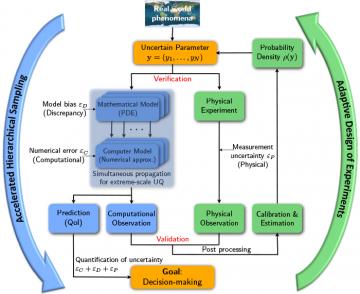Project Status: Inactive
The goal of this project is to establish a modern mathematical and statistical foundation that will enable next-generation, complex, stochastic predictive simulations. Such a foundation is critical to realizing the potential of future computing platforms, including exascale, and will ultimately enable scientists to address a fundamental question, namely "how do the uncertainties ubiquitous in all modeling efforts affect our predictions and understanding of complex phenomena?" Our collaborative approach to uncertainty quantification (UQ) combines novel paradigms in applied mathematics, statistics and computational science into a unified framework, which we call an Environment for Quantifying Uncertainty: Integrated aNd Optimized at the eXtreme-scale (EQUINOX).

What is EQUINOX?
EQUINOX is a multi-institutional ASCR funded effort to to establish a modern mathematical and statistical foundation that will enable next-generation, complex, stochastic predictive simulations. Such a foundation is critical to realizing the potential of fu- ture computing platforms, including exascale, and will ultimately enable scientists to address a fundamental question, namely "how do the uncertainties ubiquitous in all modeling efforts affect our predictions and understanding of complex phenomena?" Examples include both epistemic (lack of knowledge) and aleatoric (intrinsic variability) uncertainties and encompass uncertainty coming from inaccurate physical measurements, bias in mathematical descriptions, as well as errors coming from numerical approximations of computational simulations. Because it is essential for dealing with realistic experimental data and assessing the reliability of predictions based on numerical simulations, advanced research in uncertainty quantification (UQ) ultimately aims to address these challenges. Our rigorous approach to UQ combines novel paradigms in applied mathematics, statistics and computational science into a unified framework, which we call EQUINOX.
Goals
The goal of EQUINOX is to effect a transition from currently used naïve non-intrusive algorithms and embedded implementations to a truly architecture-aware, predictive capability for applications that dominate the focus of the DOE mission. Our rigorous UQ methodology includes:
- Novel adaptive hierarchical approaches for low-discrepancy sampling with sufficient volumetric coverage of the input density; interpolation and approximation in those regions; and detection of events, including rare events, in high-dimensional parameter spaces;
- Advanced multi-level methods for alleviating the complexity and accelerating the solutions of both deterministic and stochastic extreme-scale solvers;
- A revolutionary, architecture-aware, UQ paradigm to evaluate samples in parallel through a multi- level embedded propagation scheme whereby collections of samples are executed asynchronously and samples within each collection are propagated simultaneously at the node and processor core levels;
- Innovative, adaptive and robust experimental design strategies that intelligently gather data from both computer simulations and physical experiments so as to reduce variability in the estimate of the un- known parameters and the uncertainty in predicted responses.
Last Updated: February 25, 2021 - 2:49 pm